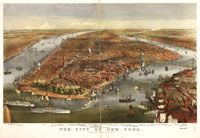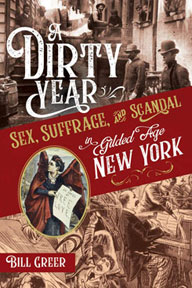19TH CENTURY AFTER 1860
Click on each image to pop up a larger version.
1870: This view published by Currier & Ives is an early one depicting the Brooklyn Bridge. It’s a fantasy. The Manhattan tower was completed in mid-1876. By mid-1881, the cables spanned the river. But while the bridge deck extended from both towers, the pieces were nowhere near connecting. The bridge opened in 1883. [Library of Congress]
1875: Another view from Currier & Ives, again with the unbuilt Brooklyn Bridge. Note in this image and the next, the shoreline has been extended again. {Library of Congress]
1879: An innovative clothier adopted this view to promote his business – “New York: a birdseye view from the harbor, showing Manhattan Island in its surroundings, with various points of interest in the city and the location of Rogers, Peet & Co.'s building, the exact center of the clothing trade in New York City.”
1892: This Currier & Ives print reverses the perspective. Lower Manhattan with Castle Gardens is in the foreground and the image extends to the horizon beyond the harbor. The Statue of Liberty appears for the first time. It was erected and dedicated in 1886. [Yale University Art Gallery]
1896: This panorama by William W. Silver patches together four photographs. For the first time, the real Brooklyn Bridge comes into the view. It opened in 1883. [Library of Congress]
Bill's Books
A Novel of New Amsterdam
The Mevrouw Who Saved Manhattan
"[A] romp through the history of New Netherland that would surely have Petrus Stuyvesant complaining about the riot transpiring between its pages."
- de Halve Maen, Journal of the Holland Society of New York





